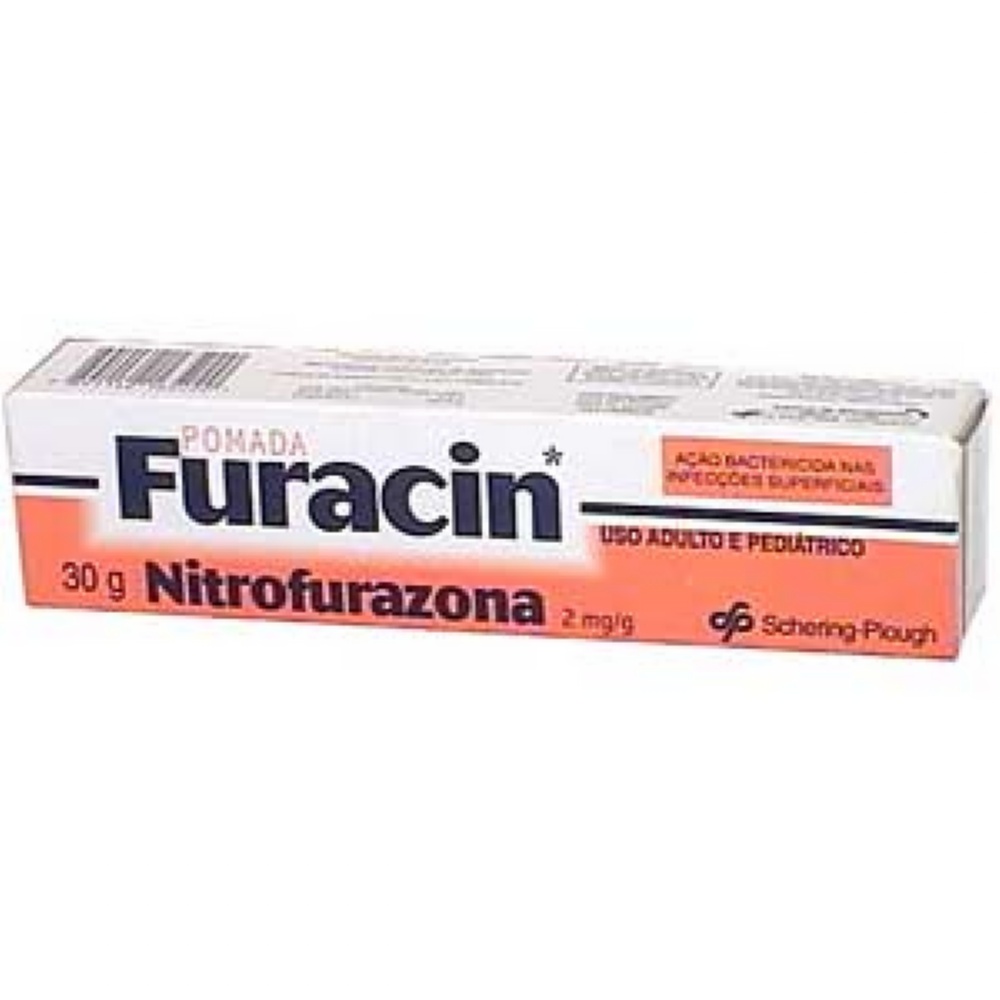

FURACIN 2 mg/g OINTMENT

Ask a doctor about a prescription for FURACIN 2 mg/g OINTMENT

How to use FURACIN 2 mg/g OINTMENT
Introduction
PACKAGE LEAFLET: INFORMATION FOR THE USER
Furacin 2 mg/g ointment
Nitrofural
Read all of this leaflet carefully before you start using this medicine.
|
Contents of the pack:
- What Furacin ointment is and what it is used for
- Before you use Furacin ointment
- How to use Furacin ointment
- Possible side effects
- Storing Furacin ointment
- Further information
1. What is Furacin ointment and what is it used for
Nitrofural, the active substance of the medicine, is a nitrofuran derivative with antiseptic and disinfectant activity, with antibacterial action against most pathogenic germs that normally cause skin infections.
Furacin ointment is indicated in adults for local application in:
Alternative treatment of second and third degree burns. Skin infections. Preparation of skin surfaces for skin grafts, where bacterial contamination may cause graft rejection or infection in the donor site, especially in centers with a history of bacterial resistance.
2. Before using Furacin ointment
Do not use Furacin ointment
- If you are allergic (hypersensitive) to the active substance or any of the other ingredients of Furacin ointment.
Be cautious when using Furacin ointment
- If you have kidney disease, as the macrogoles present as excipients may be absorbed and accumulate, increasing the risk of adverse reactions.
- If there is an overgrowth of germs not sensitive to treatment with nitrofural (another infection with worsening of the lesion or irritation in the treated area).
Using other medicines
Tell your doctor or pharmacist if you are using or have recently used other medicines, including those obtained without a prescription.
No interaction studies have been performed.
Use in children
The safety and efficacy of nitrofural in children have not been established (see section 3: How to use Furacin ointment).
Use in elderly patients
Elderly patients, who are likely to have a greater deterioration of renal function due to age, may require lower doses of nitrofural (see section 2, above: Use in elderly patients).
Pregnancy and breastfeeding
Consult your doctor or pharmacist before using any medicine.
There is no adequate information on the use of nitrofural in pregnant women. During pregnancy, Furacin ointment should only be used if the possible benefit justifies any potential risk to the fetus.
It is not known whether this medicine passes into breast milk. Therefore, a decision should be made to either continue or discontinue breastfeeding or continue or discontinue treatment with Furacin, taking into account the benefit of breastfeeding for the child and the benefit of treatment with Furacin ointment for the mother.
Driving and using machines
It is very unlikely that Furacin will affect your ability to drive and use machines.
Important information about some of the ingredients of Furacin ointment
This medicine contains macrogoles (polyethylene glycols) as excipients; if you have kidney disease, you should be cautious, as they may be absorbed and accumulate, increasing the risk of adverse effects on the kidneys, such as progressive deterioration. You should inform your doctor.
3. How to use Furacin ointment
Follow the instructions for administration of Furacin ointment exactly as indicated by your doctor. Consult your doctor or pharmacist if you have any doubts.
Furacin ointment is for cutaneous use.
The normal dose is:
Adults: Apply directly to the lesion or spread previously on a sterile gauze and cover the lesion; apply once a day or every few days, depending on the dressing technique.
If symptoms worsen or do not improve after 3 days of treatment with Furacin ointment, you should discontinue treatment and consult your doctor.
There is no experience in children.
Elderly patients, who are likely to have a greater deterioration of renal function due to age, may require lower doses of nitrofural (see section 2, above: Use in elderly patients).
If you use more Furacin ointment than you should
If your kidney function is normal, applying the product for cutaneous use is unlikely to cause an overdose. In case of accidental ingestion, note that nitrofural is a toxic product when ingested and adverse effects affect the nerves, and in patients with glucose-6-phosphate dehydrogenase deficiency, hemolysis (release of hemoglobin contained in red blood cells) may occur.
If you have used more Furacin ointment than you should, or in case of accidental ingestion, consult your doctor or pharmacist immediately, or go to a medical center or call the Toxicology Information Service. Telephone (91) 5620420.
If you forget to apply Furacin ointment
Do not use a double dose to make up for forgotten doses.
If you forget a dose, apply it as soon as possible and continue with your usual dosing schedule.
4. Possible side effects
Like all medicines, Furacin ointment can cause side effects, although not everybody gets them.
The side effects observed are described below according to their frequency of occurrence.
Disorders of the skin and subcutaneous tissue
Frequent: at least 1 in 100 patients may experience allergic reactions, such as contact dermatitis (redness, itching, rash, swelling, etc.).
Unknown frequency (cannot be estimated from the available data): mycoses due to overgrowth of fungi may also appear.
Renal and urinary disorders
Unknown frequency (cannot be estimated from the available data): in patients with kidney disease, symptoms of progressive renal deterioration may occur if macrogoles (excipients) accumulate, such as increased urea nitrogen in the blood, anion gap, and metabolic acidosis (see section 2, subsection: Important information about some of the ingredients of Furacin ointment).
If you experience any of the side effects, or if you notice any side effects not listed in this leaflet, please tell your doctor or pharmacist.
5. Storing Furacin ointment
Keep out of the reach and sight of children.
Do not use Furacin ointment after the expiration date stated on the packaging after EXP. The expiration date is the last day of the month indicated.
Do not store above 30°C and keep the container perfectly closed to protect it from direct sunlight, intense fluorescent light, and alkaline materials.
Medicines should not be disposed of via wastewater or household waste. Deposit the containers and medicines you no longer need at the SIGRE point in the pharmacy. In case of doubt, ask your pharmacist how to dispose of the containers and medicines you no longer need. This will help protect the environment.
6. Further information
Composition of Furacin ointment
- The active substance is Nitrofural. Each gram of ointment contains 2 mg of Nitrofural.
- The other ingredients (excipients) are: macrogol 300, macrogol 1500, macrogol 4000, and purified water.
Appearance and packaging of the product
Furacin ointment is presented in the form of an ointment in a tube containing 30 g and 100 g; and in a plastic jar of 500 g (clinical packaging).
Marketing authorization holder and manufacturer
SEID, S.A.
Carretera de Sabadell a Granollers Km, 15
08185 - LLIÇÀ DE VALL (BARCELONA)
This leaflet was approved in March 2007.
Detailed and updated information on this medicine is available on the website of the Spanish Agency for Medicines and Health Products (AEMPS) http://www.aemps.gob.es/.
- Country of registration
- Availability in pharmaciesSupply issue reported
- Active substance
- Prescription requiredYes
- Manufacturer
- This information is for reference only and does not constitute medical advice. Always consult a licensed doctor before taking any medication. Oladoctor is not responsible for medical decisions based on this content.
- Alternatives to FURACIN 2 mg/g OINTMENTDosage form: TOPICAL SOLUTION, 0.2 gActive substance: nitrofuralManufacturer: Seid S.A.Prescription requiredDosage form: TOPICAL SOLUTION, 3 g hydrogen peroxide / 100 mlActive substance: hydrogen peroxideManufacturer: Pharmex Advanced Laboratories S.L.Prescription not requiredDosage form: TOPICAL SOLUTION, 30 mg/mlActive substance: hydrogen peroxideManufacturer: Peroxfarma S.A.Prescription not required
Alternatives to FURACIN 2 mg/g OINTMENT in other countries
The best alternatives with the same active ingredient and therapeutic effect.
Alternative to FURACIN 2 mg/g OINTMENT in Polónia
Alternative to FURACIN 2 mg/g OINTMENT in Ukraine
Online doctors for FURACIN 2 mg/g OINTMENT
Discuss dosage, side effects, interactions, contraindications, and prescription renewal for FURACIN 2 mg/g OINTMENT – subject to medical assessment and local rules.














